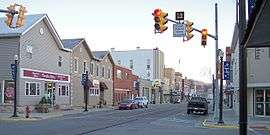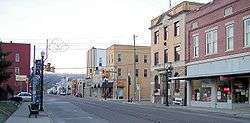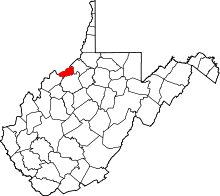St. Marys, West Virginia
| St. Marys, West Virginia | |
|---|---|
| City | |
|
2nd Street in the central business district of St. Marys in 2006 | |
|
Location of St. Marys, West Virginia | |
| Coordinates: 39°23′47″N 81°11′59″W / 39.39639°N 81.19972°WCoordinates: 39°23′47″N 81°11′59″W / 39.39639°N 81.19972°W | |
| Country | United States |
| State | West Virginia |
| County | Pleasants |
| Area[1] | |
| • Total | 1.02 sq mi (2.64 km2) |
| • Land | 1.02 sq mi (2.64 km2) |
| • Water | 0 sq mi (0 km2) |
| Elevation | 623 ft (190 m) |
| Population (2010)[2] | |
| • Total | 1,860 |
| • Estimate (2012[3]) | 1,848 |
| • Density | 1,823.5/sq mi (704.1/km2) |
| Time zone | Eastern (EST) (UTC-5) |
| • Summer (DST) | EDT (UTC-4) |
| Area code(s) | 304 |
| FIPS code | 54-71356[4] |
| GNIS feature ID | 1552772[5] |


St. Marys is a city in Pleasants County, West Virginia, in the United States. The population was 1,860 at the 2010 census. It is the county seat of Pleasants County.[6] St. Marys was established in 1849 by Alexander Creel, who is said to have had a vision of Mary while passing the townsite by boat on the Ohio River.[7]
St. Marys is part of the Parkersburg-Marietta-Vienna, WV-OH Metropolitan Statistical Area.
Train tracks run down the middle of 2nd Street in St. Marys, and freight trains running through the middle of downtown St. Marys are a common sight. It is one of the few towns in the United States where freight trains actually share city streets with automotive traffic.
Geography
St. Marys is located at 39°23′47″N 81°11′59″W / 39.39639°N 81.19972°W (39.396393, -81.199701),[8] along the Ohio River at the mouth of Middle Island Creek.[9] Middle Island, which is part of the Ohio River Islands National Wildlife Refuge, is located in the Ohio opposite St. Marys; a bridge connects the city to the island.[10]
According to the United States Census Bureau, the city has a total area of 1.02 square miles (2.64 km2), all of it land.[1]
Demographics
| Historical population | |||
|---|---|---|---|
| Census | Pop. | %± | |
| 1880 | 350 | — | |
| 1890 | 520 | 48.6% | |
| 1900 | 825 | 58.7% | |
| 1910 | 1,358 | 64.6% | |
| 1920 | 1,648 | 21.4% | |
| 1930 | 2,182 | 32.4% | |
| 1940 | 2,201 | 0.9% | |
| 1950 | 2,196 | −0.2% | |
| 1960 | 2,443 | 11.2% | |
| 1970 | 2,348 | −3.9% | |
| 1980 | 2,219 | −5.5% | |
| 1990 | 2,148 | −3.2% | |
| 2000 | 2,017 | −6.1% | |
| 2010 | 1,860 | −7.8% | |
| Est. 2015 | 1,858 | [11] | −0.1% |
2010 census
As of the census[2] of 2010, there were 1,860 people, 841 households, and 543 families residing in the city. The population density was 1,823.5 inhabitants per square mile (704.1/km2). There were 954 housing units at an average density of 935.3 per square mile (361.1/km2). The racial makeup of the city was 99.0% White, 0.1% African American, 0.2% Native American, 0.2% Asian, 0.1% from other races, and 0.4% from two or more races. Hispanic or Latino of any race were 1.3% of the population.
There were 841 households of which 27.6% had children under the age of 18 living with them, 47.2% were married couples living together, 11.7% had a female householder with no husband present, 5.7% had a male householder with no wife present, and 35.4% were non-families. 31.2% of all households were made up of individuals and 16% had someone living alone who was 65 years of age or older. The average household size was 2.21 and the average family size was 2.73.
The median age in the city was 43.9 years. 20.5% of residents were under the age of 18; 8% were between the ages of 18 and 24; 23.2% were from 25 to 44; 28.8% were from 45 to 64; and 19.5% were 65 years of age or older. The gender makeup of the city was 49.1% male and 50.9% female.
2000 census
As of the census[4] of 2000, there were 2,017 people, 879 households, and 588 families residing in the city. The population density was 2,074.1 people per square mile (802.9/km²). There were 961 housing units at an average density of 988.2 per square mile (382.5/km²). The racial makeup of the city was 98.56% White, 0.05% African American, 0.64% Native American, 0.30% Asian, 0.15% from other races, and 0.30% from two or more races. Hispanic or Latino of any race were 0.25% of the population.
There were 879 households out of which 29.2% had children under the age of 18 living with them, 52.0% were married couples living together, 11.3% had a female householder with no husband present, and 33.0% were non-families. 30.9% of all households were made up of individuals and 18.8% had someone living alone who was 65 years of age or older. The average household size was 2.29 and the average family size was 2.81.
In the city the population was spread out with 22.2% under the age of 18, 7.1% from 18 to 24, 25.4% from 25 to 44, 24.5% from 45 to 64, and 20.8% who were 65 years of age or older. The median age was 42 years. For every 100 females there were 90.1 males. For every 100 females age 18 and over, there were 84.3 males.
The median income for a household in the city was $30,755, and the median income for a family was $37,621. Males had a median income of $31,000 versus $21,522 for females. The per capita income for the city was $17,206. About 12.8% of families and 15.3% of the population were below the poverty line, including 19.0% of those under age 18 and 12.3% of those age 65 or over.
See also
References
- 1 2 "US Gazetteer files 2010". United States Census Bureau. Retrieved 2013-01-24.
- 1 2 "American FactFinder". United States Census Bureau. Retrieved 2013-01-24.
- ↑ "Population Estimates". United States Census Bureau. Retrieved 2013-06-26.
- 1 2 "American FactFinder". United States Census Bureau. Retrieved 2008-01-31.
- ↑ "US Board on Geographic Names". United States Geological Survey. 2007-10-25. Retrieved 2008-01-31.
- ↑ "Find a County". National Association of Counties. Retrieved 2011-06-07.
- ↑ Kenny, Hamill (1945). West Virginia Place Names: Their Origin and Meaning, Including the Nomenclature of the Streams and Mountains. Piedmont, WV: The Place Name Press. p. 550.
- ↑ "US Gazetteer files: 2010, 2000, and 1990". United States Census Bureau. 2011-02-12. Retrieved 2011-04-23.
- ↑ West Virginia Atlas & Gazetteer. Yarmouth, Me.: DeLorme. 1997. p. 23. ISBN 0-89933-246-3.
- ↑ United States Fish and Wildlife Service. "Refuge access". Ohio River Islands National Wildlife Refuge. Retrieved 2007-05-07.
- ↑ "Annual Estimates of the Resident Population for Incorporated Places: April 1, 2010 to July 1, 2015". Retrieved July 2, 2016.
- ↑ "Census of Population and Housing". Census.gov. Retrieved June 4, 2015.

